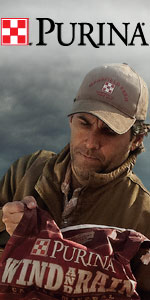Blach Anticipates Optimistic Future, Especially for Cow-Calf Producers
“Most profitable time ahead as any time in history.”
BOZEMAN, MONT. (Sept. 15, 2010) — Cattle-Fax economist Randy Blach painted an optimistic picture for beef producers as he addressed the more than 600 attendees at the National Angus Conference Sept. 15 in Bozeman, Mont. The conference was followed by two and a half days of tours at several well-known Montana Angus seedstock ranches.
 Randy Blach
Randy Blach
Randy Blach The future, "looks pretty good," Blach told cattlemen. "I think there is a tremendous opportunity for cow-calf producers who know their costs, manage production and have market savvy. The cow-calf sector could have the most profitable three to four years ahead as any time in history.”
Blach attributed his bullish outlook to the economic recovery that is under way and the current supply and demand picture for beef. He explained that beef cow inventory is at an all-time low, creating tight supplies, while demand — particularly global demand — is beginning to gain momentum.
For 2010, demand is up 5%, with export demand showing strong potential for growing, Blach reported. “Demand growth will be slow, but we believe the worst is behind us.”
Along with that, Blach said he expects beef supply to remain tight into 2011. “We don’t have enough beef to meet demand, and the beef cow herd is going to be 3,000-4,000 head smaller as of Jan. 1, 2011,” he stated.
If those trends continue, it should drive prices higher for all classes of cattle and allow for profitability — even despite increasing production costs, Blach predicted. “Cow prices are going to get higher; they may reach all time highs very easily. Fed cattle and feeder calf [prices] could be higher as well.”
Specifically, Blach said he anticipates market conditions could lead to fed cattle averaging $94-$95 per hundredweight (cwt.) by the end of this year and be $3-$4 higher than that next year. If demand goes up significantly, prices could go above $100 per cwt.
For cow-calf producers, Blach said some industry expansion will be needed to meet the growing demand — and that spells opportunity.
“When you see that the national herd is smaller and is going to be even smaller on Jan. 1, that means it will be three years until we can impact production,” he noted. “What’s the opportunity? You can see what the masses are doing. Not many are keeping heifers or buying a few more cows, so those who do will have a pretty good pay day.
“We need a few of you to keep a few more heifers,” he continued. “We don’t need a huge expansion, but we need a stable herd with a little bit of uptick.”
Blach explained that with genetic improvement in the industry contributing to increased market weights, the industry does not need 5 million more cows to meet the anticipated growth in demand. But, he said, “we do need 600,000-700,000 more cows by the end of this decade.”
He added, “Cow-calf producers are going to have a good run the next several years. There’s a chance we’ll see cow-calf prices up where we’ve never experienced.”
Blach tempered his optimism noting that much will still hinge on signals sent by demand, the ability to have access to global export markets, and commodity grain prices — particularly for corn.
“A risk is the corn price, which is projected at $5.50 by spring 2011,” Blach said. “This is a very risky business. The market is going to be there with opportunities, but so will the risk. You may need to consider using futures and options to be able to take some of those profits when they are there.”
Blach also expressed his concern over the currently proposed GIPSA rule by USDA. “You need to read it and understand what the ramifications are and then weigh in on it,” he told producers. “The genetic programs you’ve invested in are at risk. It could set us back to commoditized prices of the 1970s and 80s when profit margins averaged $2.04 per head.”
In comparison, he credited premium beef programs — such as Certified Angus Beef® (CAB®) — with adding another $20-$22 per head — which equates to $5-$7 million to the industry annually. Blach questioned, “And some don’t think these markets work? ... That’s what a free market will do, and we need more of it.”
Rather, Blach emphasized the need to continue gaining access to export markets and allowing for free markets. He noted that between 2004 and today, reduced export trade due to BSE (bovine spongiform encephalopathy) has cost between $70 and $75 per head.
“Those are the kind of things our government needs to be fixing … instead of getting in our markets [with GIPSA]. Call your congressman and senator and tell them we need to get access,” Blach encouraged.
As further proof of the importance of trade, Blach said, “What we export brings 50 cents more than what we import, so that’s money in your pocket. We need trade, and we need more trade.”
In closing, Blach reiterated that cow-calf producers should evaluate expansion opportunities ahead. If market factors follow the demand trends anticipated, he told the cattlemen in attendance, “There are opportunities for some of you out in the room today.”
© Copyright 2010 Angus Productions Inc.
Editor’s Note: This article was written under contract or by staff of Angus Productions Inc. (API), which claims copyright to this article. It may not be published or distributed without the express permission of Angus Productions Inc. To request reprint permission and guidelines, contact Shauna Rose Hermel, editor, at 816-383-5270.


